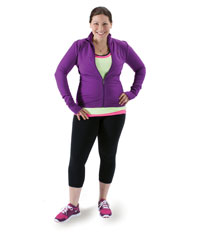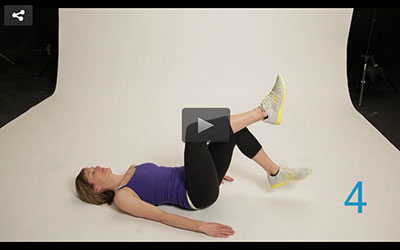Q: Postnatal Core Work
How soon after I give birth can I do core exercises again?
A: How fast you bounce back varies from woman to woman, so listen and respond to your body’s cues. “Exercise doesn’t have to be high intensity to be beneficial,” says Kara Thom, coauthor of Hot (Sweaty) Mamas: Five Secrets to Life as a Fit Mom. “The three months post-birth is a period of transition and healing. During this time, your focus — aside from that cherubic newborn — should be repairing and strengthening your core.”
Thom recommends beginning a series of five exercises within days of giving birth (allow for more time if recovering from a cesarean section). These exercises, developed by renowned physical therapist Shirley Sahrmann, are specifically geared to close the diastasis recti, where the abdomen splits to accommodate a growing baby. (Click on the link in Related Content below for the video demo of these exercises.)
While it’s tempting to focus on what you can see, your underlying pelvic floor is the musculature that’s most in need of conditioning right now. You can also start doing Kegels immediately, says Thom, but make sure you’re doing them correctly or you might actually weaken your pelvic floor. While you probably already know to contract your pelvic floor during a Kegel, it’s equally important to release and relax the muscles as the second step of the exercise.
Every muscle that connects to the pelvic floor requires strengthening, most notably the glutes. (Yep, the glutes are attached to your pelvic floor.) And a great way to strengthen your gluteus muscles is to squat, and squat deeply. Don’t save these squats for the gym — do them instead of sitting or bending over, and build them into your everyday routine (say, when you need to lift the baby from the car seat). After a few months of following this regimen, your core might be stronger than it was before pregnancy, and you’ll be able to get back to your former fitness routine without risking injury.
Q: Resistant Carbs
I saw a magazine cover line that said eating “resistant carbohydrates” will help me lose belly fat. What does that term mean?
A: There may eventually prove to be some truth to this claim, but I wouldn’t recommend putting a lot of stock in it just yet. The idea is this: Like fiber, resistant carbohydrates don’t get fully digested in the body. Rather, they “resist” getting broken down into glucose, and therefore don’t spike insulin levels or fuel weight gain the same way most simple carbs do. Resistant carbs may also increase gut microflora, and they naturally exist in foods such as whole grains, beans, legumes, and some fruits and vegetables; they’re also found in white rice, pasta and potatoes — after they’ve been cooked and cooled. In addition, food scientists have engineered resistant starch powders that can be added to foods to give them that charmingly resistant quality.
But don’t grab for those cold potatoes just yet, because all this hype is based on rat studies. Researchers fed rats resistant carbs for a period of time equivalent to eight human years, says Mike Keenan, PhD, associate professor of human nutrition and food at Louisiana State University in Baton Rouge. (So it could take a long time to get the verdict in human studies.) As for the specificity of the belly-fat-reduction promise, that stems from the way the scientists measured the rat fat: from the belly only. “Abdominal fat correlates well with total body fat in rodents,” explains Keenan. So chances are that resistant carbs don’t target belly fat.
The rat studies are promising, Keenan says, but more studies — human studies — are necessary. In the meantime, stick to no-gimmick nutrition consisting of a wide variety of whole, natural foods.
Q: Fitness Fixes: Workout Wardrobe Makeover
During the weight-loss process, changing the way you dress can help you reset your body image and prevent backsliding.


After Katie Rock’s father passed away in September 2008, she started putting on weight, topping out at 248 pounds last summer. “I wrapped myself in my grief, isolation and discomfort,” says Rock.
She also wrapped herself in oversized clothing — especially when she hit the gym. “I dressed to cover up everything I hated,” she says. “That, apparently, was all of me. I wore XXL T-shirts and old, baggy workout pants.”
Although Rock, 28, has since lost 75 pounds, she admits it’s been tough to shed her less-than-flattering wardrobe. It’s a conundrum for most people trying to come to grips with their shifting shape, says Pamela Peeke, MD, MPH, FACP, author of Body for Life for Women: A Woman’s Plan for Physical and Mental Transformation (Rodale Books, 2009).
“Your behaviorisms are developed in the neural networks in your brain, and they’re telling you you’re heavy, even when you’re not anymore. This is why drastic weight loss can freak people out — you have to gradually reset your baseline body image, and changing your clothes can help change the way you see yourself.”
Brighten Up
Part of that process is learning to draw positive attention to yourself: Ditch the infamous “hide-it” outfit of dark, baggy clothes, says Peeke, and add splashes of color. If you’re nervous about it, start out with small swaps: a bright headband, socks or shoes, even. Then graduate to more vivid tops, a supportive sports bra and form-fitting underwear. (What to avoid: transparent or shiny shirts, tiny outfits, ill-fitting layers, and unsupportive anything, says Peeke.)
Keep It Close
“Wearing closer-fitting exercise clothing is important from a functional point of view — you can see your form when lifting or doing yoga,” says Leslie Goldman, MPH, author of Locker Room Diaries: The Naked Truth About Women, Body Image, and Re-imagining the “Perfect” Body (Da Capo, 2007). “All sizes deserve tailored, flattering clothing options.”
Rock concurs. “I was always having to hike up my pants or worry about my shirt falling over my head during handstands,” she says. So, she asked some of the women at her gym for clothing recommendations and then set out to find some workout clothes that matched her new, trimmer shape.
“I walked into Lululemon, looked around and thought, I will not fit into any of this. But I screwed up my courage, brought some things to the dressing room, and was totally shocked to not only fit into their size-12 pants, but to look awesome in them.”





This Post Has 0 Comments